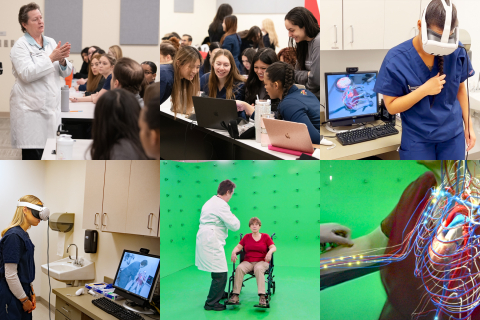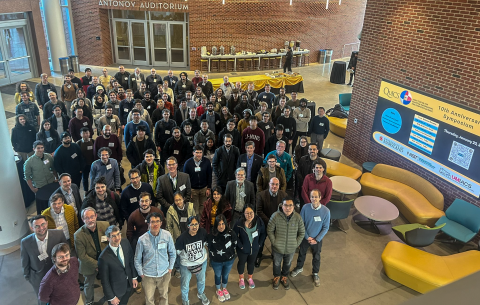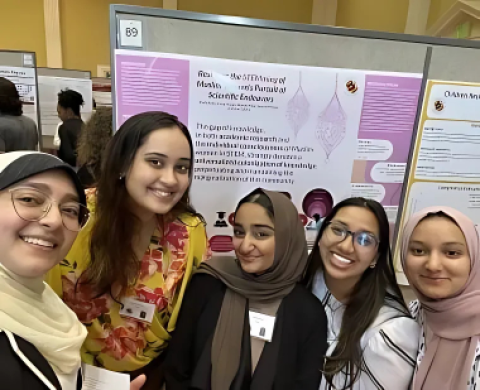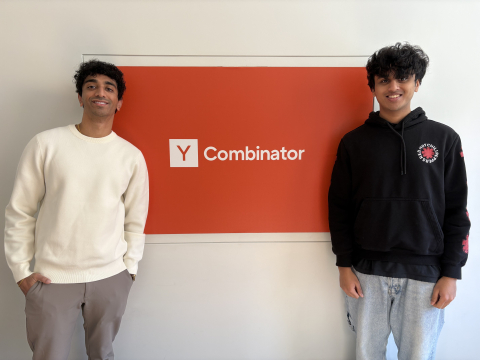Recent News & Accomplishments
2025
“Today is gonna be a really, really fun day for you,” Assistant Dean for Physician Assistant Education and Associate Professor Cheri Hendrix, DHEd, MSBME, PA-C, DFAAPA, told her class of 58 physician assistant (PA) students. In truth, it would be hard to say just who would have the most fun, the students who sat in anticipation of an exciting new high-tech learning experience, or Hendrix, who waited a very long time for this day to arrive. “I think this is really going to enrich what you know about neurologic disease,” she continued, understating her expectations a bit. For the first time,... read more
Li received the award for his research in accessibility and interactive user interface design.
Jiasheng Li , a Ph.D. student in the University of Maryland’s Department of Computer Science, has been awarded the 2024 HCIL Maryland Way Award for Research Excellence. Li received the award for his contributions to accessible user interface design and his research on multimodal interaction techniques. The award, presented annually by the Human-Computer Interaction Lab (HCIL), is the highest honor the lab gives and includes a cash prize. The Maryland Way Award for Research Excellence is given annually to a researcher whose work significantly contributes to Human-Computer Interaction (HCI)... read more
Terp promotes on-screen representation by making avatars more customizable.
If Cassandra Lewis (B.S. '09, computer science) ever feels the urge to see how she’d look with a mohawk, instead of grabbing the clippers, she just opens her laptop. As head of avatar innovation at Meta, she’s also helping billions of users of Facebook, Instagram and more bring their own style to those cute, cartoony online representations, which the company overhauled in October to allow more customization. “I do think it’s fun to have something that looks familiar and does look like me, but then I get to switch out clothing, change up looks, change up hair,” Lewis says. “I have a passion... read more
UMD alum Abhinav Gupta leads Skild AI in advancing adaptable robotics intelligence.
Softbank is negotiating a $500 million investment in Skild AI , a software company building a financial model at a $4 billion valuation. Skild AI builds general-purpose robotic intelligence using cutting-edge machine learning algorithms to create adaptable robots that function across different environments, from construction sites to factories and homes. Skild AI claims its “Skild Brain” is the first scalable robotics foundation model, capable of adapting across hardware and tasks. The company was co-founded by University of Maryland alum Abhinav Gupta (Ph.D. '09, computer science) and Deepak... read more
From NeurIPS research to Half Ironman and developing Promptly AI, Sankaralingam’s journey highlights exploration and growth in computer science.
For many students, college is a time of exploration, self-discovery and growth—both academically and personally. At the University of Maryland, this transformative experience has guided students like junior computer science major Ananth Sankaralingam (B.S. ’26, computer science) as they navigate their unique paths to success. Balancing academic research, entrepreneurial ventures and personal milestones, Sankaralingam has forged a unique and dynamic journey. From presenting research at NeurIPS in Vancouver to creating PolitiMeme , a project examining technology’s role in social discourse and... read more
QuICS marks a decade of innovation as UMD accelerates quantum science initiatives.
The Joint Center for Quantum Information and Computer Science (QuICS) at the University of Maryland celebrated its 10th anniversary on Thursday, January 23, 2025, at the Brendan Iribe Center for Computer Science and Engineering . The event, organized by QuICS and the National Institute of Standards and Technology (NIST), brought together over 100 researchers in quantum science and featured informative talks, a poster session and a panel discussion on the future of quantum information over the next five years. Established in collaboration with NIST, QuICS has spent the last decade advancing... read more
Exploring the intersection of faith, culture and STEM education.
In Western cultures, science, technology, engineering and math (STEM) research is known for its rigid procedural methodology. Most experimental research in STEM relies on objectivity and the removal of bias. However, Vivian Ali Zohery ’17, M.A. ’20, Ph.D. ’24, who recently completed her doctorate in teaching and learning, policy and leadership, mathematics and science education specialization, at the University of Maryland, believes that instilling elements of faith and culture can enhance meaningful research. Zohery, who comes from a rural Egyptian background, began her mission to... read more
Founders Samai Patel and Nand Vinchhi embark on a journey to help companies reduce their architectural tech debt.
Startups often embark on transformative journeys, navigating challenges and seizing opportunities to bring their ideas to life. Few paths are as impactful as being accepted into Y Combinator , the prestigious accelerator known for propelling companies like Airbnb and Stripe to global recognition. For Axal , a student-led startup from the University of Maryland’s Department of Computer Science, this milestone marks a significant step forward in its mission to modernize legacy systems using artificial intelligence. Co-founded by UMD computer science majors Samai Patel and Nand Vinchhi , the... read more
Jim Purtilo discusses the effectiveness of cybersecurity labels and their potential impact on consumer trust.
The White House introduced a new label for Internet-connected devices this week after a public notice and input period that spanned eight months. The U.S. Cyber Trust Mark, which was authorized by the Federal Communications Commission (FCC) in a bipartisan and unanimous vote, will be employed on so-called “smart products” sold in the United States by 11 companies. It will begin to appear later this year, to help American consumers determine whether the smart devices are safe for use at home. It will include a range of devices including home security cameras, TVs, fitness trackers, baby... read more
Gao’s research focuses on computer vision and machine learning.
Ruohan Gao will join the University of Maryland’s Department of Computer Science as an assistant professor, where he will lead the Multisensory Machine Intelligence Group. His research centers on computer vision and machine learning, focusing on multisensory learning—integrating sight, sound and touch. “I’m thrilled to start this new chapter of my career at UMD’s Department of Computer Science,” Gao said. “It’s such an exciting journey ahead to collaborate with brilliant colleagues, work with talented students and contribute to the department’s tradition of excellence. I can’t wait to dive... read more









